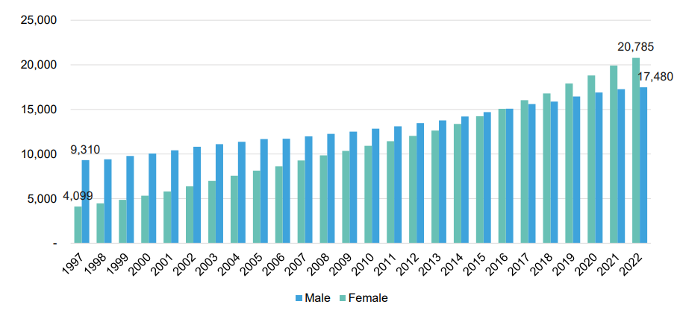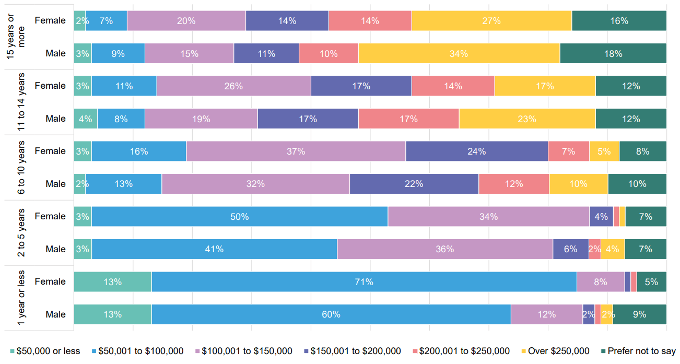NSW’s 40,000 strong solicitor profession stepping toward gender equity
Breadcrumb
- Home
- Publications and resources
- Nsws 40000 strong solicitor profession stepping
A fresh study commissioned by the Law Society of NSW has shown modest positive momentum towards women in the legal profession enjoying the career expectations of their male colleagues.
President of the Law Society of NSW Cassandra Banks said the 2022 Annual Profile of Solicitors NSW published today has revealed a growing, vibrant and diverse profession that’s facing up to the challenge of attracting and retaining legal talent.
“I’m encouraged by results that show some positive movement among private practice leadership positions since last year’s Profile that revealed persistent gaps between men and women practicing law.” Ms Banks said.
Each year the Law Society publishes a profile of practicing solicitors in NSW, compiled by consulting firm Urbis from the Law Society’s Registry and a voluntary survey of solicitors when renewing their Practising Certificates.
Ms Banks welcomed growth of three percent in the number of solicitors with NSW Practising Certificates since the 2021 profile. The data captured on 31 October 2022 shows NSW had 38,265 solicitors. For the sixth year running females outnumbered males in the profession. In 2022 this was by 54 to 46 percent - the same proportion as in 2021.
“I’m happy to reveal that, in the first quarter of this year, the number of solicitors holding NSW Practising Certificates passed 40,0000. This milestone demonstrates that the law continues to attract those who are driven to make meaningful contributions to their communities,” Ms Banks said.
Consistent with the results of the 2022 National Profile of Solicitors published in May, NSW’s private practice sector, which employs 68 percent of the state’s solicitors, is now gender balanced.
“While the overall private practice numbers are even, this Profile shows a pleasing, if gradual, increase in the proportion of women who hold principal or partner roles to 35 percent (up two percent from last year). In 2013, only 24 percent of these leadership roles in private practice were female,” Ms Banks said.
“Majority female employment has continued in the corporate (62 percent) and government (69 percent) legal sectors. I’m heartened by the achievement in these sectors of gender equity in leadership, as women now hold a slight majority of Group General Counsel and Head of Legal Team positions (corporate 52 percent and government 53 percent).
Ms Banks said the 2022 Profile has shown a continuing pay gap between the genders regardless of age, years since admission or the sector in which a solicitor is employed.
“The proportion of female solicitors on incomes over $150,000 has increased (from 28 to 31 percent). However, for the third year in a row, nine percent more males reported the same income level.”
Ms Banks said the Law Society is committed to supporting law firms to address this imbalance with the publication later this year of a guide to improving equitable remuneration in the legal profession.
“Firms who’ve signed the Law Society’s Charter for the Advancement of Women and other leading firms have contributed to the document, in concert with our Diversity and Inclusion Committee,” Ms Banks said.
“Their work has been critical to addressing one of my President’s Priorities for 2023 of working on closing the gender pay gap and recognising equitable workplace arrangements. I’m also grateful for the valuable work of my predecessor, Joanne van der Plaat, for the progress she made towards this goal.”
In preparation for the launch of the guide, the Law Society will highlight actions firms can take to recognise that gender equality makes sense both as a value and a business imperative. These include increasing transparency around compensation and promoting flexible work arrangements which can benefit everyone in the workplace.
Ms Banks said the profession continues to grow towards reflecting the cultural diversity of NSW, with 30 percent of respondents to the Practicing Certificate survey indicating they were born overseas.
“This represents a one percent increase from the previous year. While this is encouraging, only 0.9 percent of solicitors identified in the survey as Aboriginal and Torres Strait Islanders,” Ms Banks said.
More ‘pipeline’ initiatives are needed to address structural barriers to Aboriginal and Torres Strait Islanders entering the profession. The Legal Aid NSW/Macquarie University Aboriginal Legal Career Pathways program is a fine example of such an initiative.”
Find the 2022 Annual Profile of Solicitors NSW here. The Law Society expects to publish the next Annual Profile of Solicitors NSW in mid-2024. A snapshot of the profession and highlights of the profile are reproduced on following pages.
MEDIA CONTACT:
Damien Smith | Director, Media and Public Relations
The Law Society of New South Wales
M: +61 417 788 947 | E: Damien.Smith@lawsociety.com.au
2022 Annual Profile of Solicitors NSW
Snapshot as at 31 October 2022:
|
Number of solicitors 38,265 Female: 20,785 (54%) Male: 17,480 (46%) |
Private practice solicitors in principal or partnership roles Female: 35% Male: 65% |
|
Corporate sector solicitors in leadership roles Female: 52% Male: 48% |
Government sector solicitors in leadership roles Female: 53% Male: 48% |
Gender Pay Gap
|
Females |
Males |
|
|
Solicitors 30-34 |
||
|
Earning less than $150k |
61% |
58% |
|
Earning more than $150k |
29% |
34% |
|
Solicitors 35-39 |
||
|
Earning more than $200k |
28% |
38% |
|
Solicitors 40-49 |
||
|
Earning more than $250k |
24% |
35% |
Year on year growth in private law practices 1.4% (now 7,296)
Cultural Diversity
Born overseas 30% (of those, 42% born in Asia)
Concentration in larger firms
Private practices with more than 40 principals make up 0.2% of all NSW practices but employ 26% of NSW solicitors.
Number of male and female solicitors over time:

Income by gender and years since admission across practice sectors:


